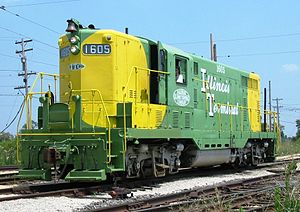GP7

ITC 1605, at the Illinois Railway Museum
|
|||||||||||||||||||||||||||||||||||||||||||||||||||||
|
|||||||||||||||||||||||||||||||||||||||||||||||||||||
|
|||||||||||||||||||||||||||||||||||||||||||||||||||||
|
|||||||||||||||||||||||||||||||||||||||||||||||||||||
|
|||||||||||||||||||||||||||||||||||||||||||||||||||||
| Type and origin | |
|---|---|
| Power type | Diesel-electric |
| Builder |
General Motors Electro-Motive Division (EMD) General Motors Diesel (GMD/GMDD) |
| Build date | October 1949 – May 1954 |
| Total produced | 2,729 (plus 5 B units) |
| Specifications | |
|---|---|
| Configuration: |
|
| • AAR | B-B |
| Gauge | 4 ft 8 1⁄2 in (1,435 mm) standard gauge |
| Wheel diameter | 40 in (1.016 m) |
| Minimum curve | 19° (301 ft (91.74 m) radius) |
| Wheelbase | 40 ft (12.19 m) |
| Length | 55 ft 11 in (17.04 m) |
| Width | 10 ft 3 in (3.12 m) |
| Height | 15 ft 0 in (4.57 m) |
| Loco weight | 246,000 lb (112,000 kg) |
| Fuel capacity | 1,600 US gal (6,100 l; 1,300 imp gal) |
| Lubricant cap. | 200 US gal (760 l; 170 imp gal) |
| Coolant cap. | 230 US gal (870 l; 190 imp gal) |
| Sandbox cap. | 18 cu ft (510 dm3) |
| Prime mover | EMD 567B |
| RPM range | 275–800 |
| Engine type | V16 Two-stroke diesel |
| Aspiration | Roots-type supercharger |
| Displacement | 9,072 cu in (148.66 L) |
| Generator | EMD D-12-B |
| Traction motors | (4) EMD D-27-B |
| Cylinders | 16 |
| Cylinder size | 8 1⁄2 in × 10 in (216 mm × 254 mm) |
| Loco brake | Independent air; optional: dynamic brakes |
| Train brakes | Air, schedule 6-BL or 6-BLC |
| Performance figures | |
|---|---|
| Power output | 1,500 hp (1,119 kW) |
| Tractive effort | 61,500 lbf (274 kN) |
| Career | |
|---|---|
| Operators | See list |
The EMD GP7 is a four-axle (B-B) road switcher diesel-electric locomotive built by General Motors Electro-Motive Division and General Motors Diesel between October, 1949 and May 1954. Power was provided by an EMD 567B 16-cylinder engine which generated 1,500 horsepower (1,119 kW). The GP7 was offered both with and without control cabs, and those built without control cabs were called a GP7B. Five GP7B's were built between March and April 1953. The GP7 was the first EMD road locomotive to use a hood unit design instead of a car-body design. This proved to be more efficient than the car body design as the hood unit cost less to build, was cheaper and easier to maintain, and had much better front and rear visibility for switching.
Of the 2,734 GP7's built, 2,620 were for American railroads (including 5 GP7B units built for the Atchison, Topeka and Santa Fe Railway), 112 were built for Canadian railroads, and 2 were built for Mexican railroads.
This was the first model in EMD's GP (General Purpose) series of locomotives. Concurrently, EMD offered a six-axle (C-C) SD (Special Duty) locomotive, the SD7.
ALCO, Fairbanks-Morse, and Baldwin had all introduced road switchers before EMD, whose first attempt at the road-switcher, the BL2 was unsuccessful in the market, selling only 58 units in the 14 months it was in production. Its replacement, the GP7, swapped the truss-framed stressed car body for an un-stressed body on a frame made from flat, formed and rolled structural steel members and steel forgings welded into a single structure (a "weldment"), a basic design which is still being employed today. Unfortunately, in heavy service, the GP7’s frame would bow and sag over time. This defect was corrected in later models. The GP7 proved very popular, and EMD was barely able to meet demand, even after opening a second assembly plant at Cleveland, Ohio. Later, locomotives in EMD's GP-series came to be nicknamed ‘Geeps’. Many GP7s can still be found in service today, although most Class 1 roads stopped using these locomotives by the early 1980s.
...
Wikipedia
